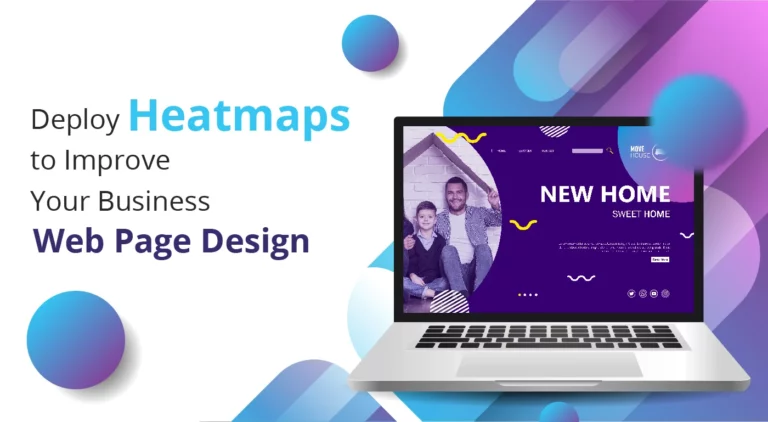6 May, 2022 | Website Design Company
Deploy Heatmaps to Improve Your Business Web Page Design

What are heat maps?
Heat maps are the data visualization tools that help you understand the interaction behaviour of visitors on your website. In analogous with the temperature/ heat, the sections of the site with greater engagement are shown, and those with lesser interaction will be shown with blue/green colour. With the help of heat maps, you can check the most clickable section, scroll as well as read section using the moves of the mouse. There are two types of heat maps: cluster and spatial. For cluster heat maps, magnitude and terms of different factors are laid out, but there is no restriction on the size of the cell. In the spatial heat maps, the location of the magnitude in any space makes much more sense. The colour scheme may vary depending upon the software and its purpose of utility.How can you deploy heat maps for website optimization?
- Understand the functionality of CTAs: The Call to action buttons (CTAs) are added to Business web page design to improve the session time of the users on the website. Using the heat maps, you will be able to check if people are clicking on those CTAs or not. Also, when one of the CTAs is redder as compared to others, you will gain an idea about the service or product of yours; that’s getting more attention.
- Know more about scrollable distance: When a visitor comes to your site intentionally, they will be searching for the products or services directly. However, normally customers navigate through the sites from search engines if they don’t find things they are exploring, they will not go through your website. To make your visitors stick to your site, you must add interactive CTAs, banners, and catchy phrases in the above-the-fold region.
- Fix & update erroneous clicks: Like your website, users are exploring several other business sites. Depending upon the utility of the website, some allow you to navigate to different pages by clicking on CTAs, while others let you click images. Sometimes, users try clicking different elements of the web page, as per their prior experience on other websites like your business.
What’s more?
By now, you already know that heat maps are amazing tools to improve your business web page design for customers. Here is a tip for you. Set up and use a VPN while creating the heat map for your website. Some of the heat map tools allow you the integration of third-party software. The security of the website may get compromised, and that’s why we recommend you to use VPN; so no one can use this important information. If you are offering digital marketing services or running website development and web designing agency, you can create heat maps for your clients. With a visual proof of the web development requirements and design tweaks, you can share the benefits that your services are causing for your clients. You can search for heat maps online and check the effectiveness of your existing web page design.Aren’t you satisfied with the results?
No worries! You can share your business web page requirements at sales@www.wedowebapps.co.uk. At WEDOWEBAPPS LTD, we offer full-fledged IT services; from website designing to digital marketing services, we can get you covered with everything.Frequently Asked Questions
Heatmaps are visual representations of user behavior on a webpage, identifying where users are clicking, scrolling, and engaging with content. They can improve business web page design by optimizing element placement, identifying usability issues, and improving user engagement.
Heatmaps can help you track and analyze a variety of metrics on your web page, including: 1. Clicks: heatmaps can show where visitors are clicking on your page, which can help you optimize your call-to-action buttons and links. 2. Scroll depth: heatmaps can show how far visitors are scrolling down your page, which can help you identify which content is most engaging and adjust your layout accordingly. 3. Time spent: heatmaps can show how long visitors are spending on each section of your page, which can help you identify which content is resonating with your audience and adjust your messaging accordingly. 4. Bounce rate: heatmaps can help you identify which parts of your page are causing visitors to leave, allowing you to optimize your content for better engagement and retention. Overall, heatmaps can be a valuable tool for improving your website's user experience and driving more conversions.
Yes, there are several tools and software available in the United Kingdom that can help you generate heatmaps for your web page. Some popular options include Crazy Egg, Hotjar, and Clicktale. These tools allow you to track user behavior and generate visual representations of where users are clicking and spending time on your website. They can provide valuable insights for improving user experience and increasing conversions. Some tools offer free trials or have different pricing tiers depending on the size of your website and number of monthly visitors.
One common mistake to avoid when interpreting heatmap data is overlooking the context of the data. Heatmap data needs to be analyzed within the context of the broader user experience, rather than just analyzing individual data points in isolation. Another mistake to avoid is assuming that the heatmap data represents the entire user population. Heatmap data can often be biased towards particular demographics or behaviors, so it's important to consider whether the heatmap data represents a representative sample of users. Finally, be aware of potential user privacy concerns when collecting and analyzing heatmap data, and ensure that you are following appropriate data privacy regulations.
It's recommended to review and update your web page design using heatmap data on a regular basis. This may vary depending on the amount of traffic your website receives and the rate of conversions, but a general rule of thumb is to review your heatmap data every 3-6 months. This will allow you to identify any emerging trends and areas of your website that could be improved to enhance user engagement and conversion rates. However, if you notice any significant changes in your website's traffic or conversion rates, it's advised to review your heatmap data more frequently to stay on top of any potential issues.

